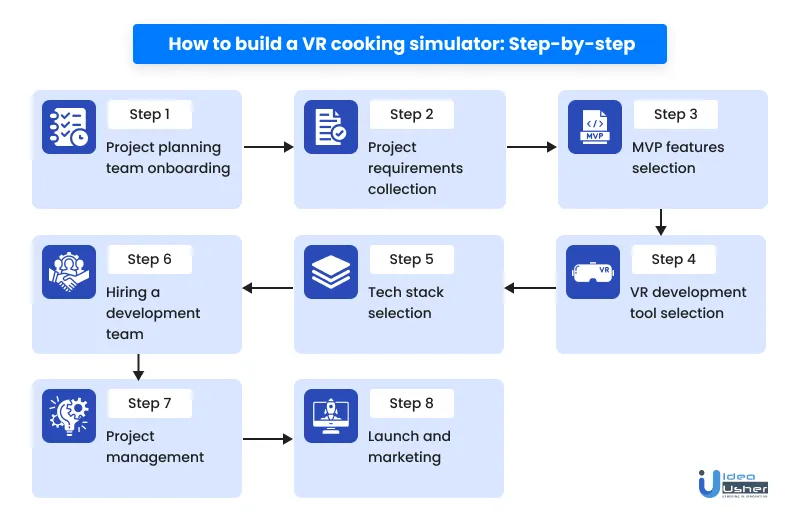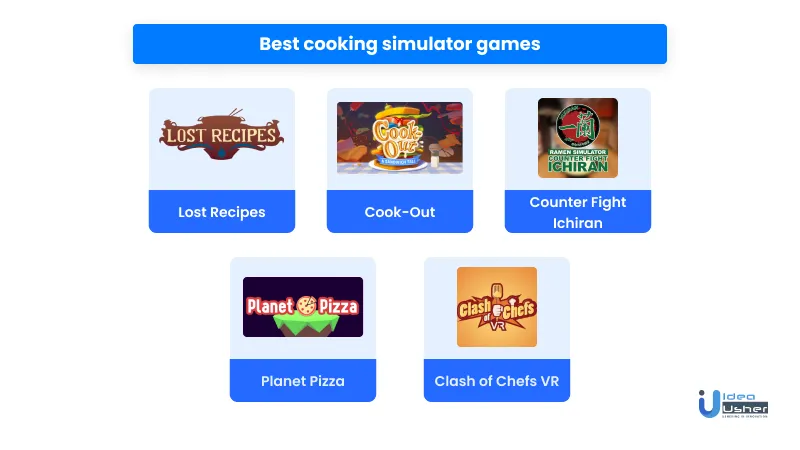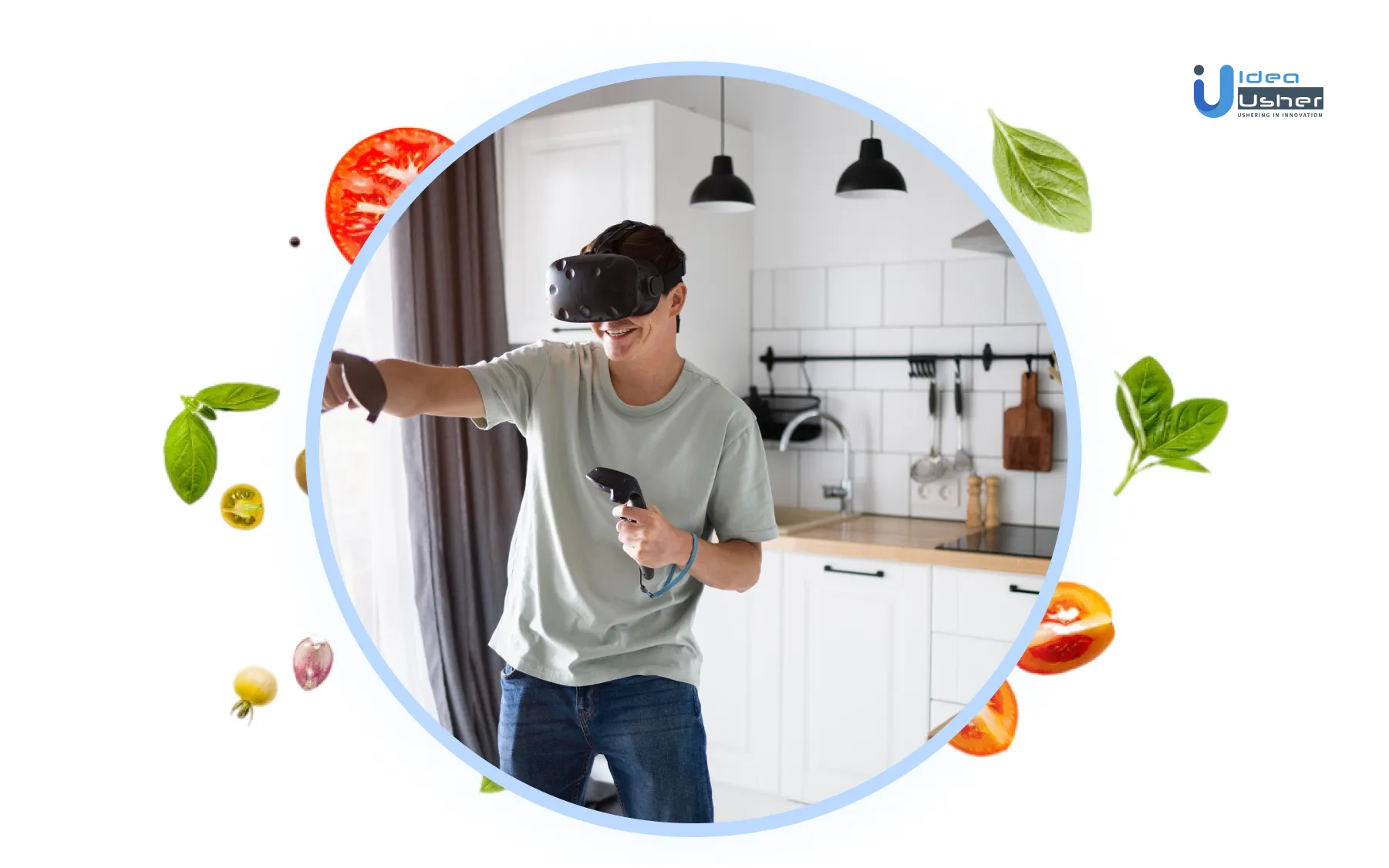Why only play a game when you can feel the game? That is exactly what VR helps you to achieve- a 3D experience of the game. With the advancements in technology, AR and VR have changed how we view entertainment, gain education, play games, and more. Cooking simulator games are one of the popular VR games that have created a buzz.
Wish to develop a cooking simulator but don’t know how? This blog will take you through the process of creating a cooking VR game.
What is VR?
Virtual Reality (VR) is an advanced technology that provides users with an unparalleled simulated experience through the combination of computer modeling and simulation. It builds an artificial three-dimensional (3-D) environment, allowing users to interact with a virtual world that mirrors reality. This isn’t just a visual spectacle; it’s a full sensory immersion.
VR creates an immersive experience by using pose tracking and 3D near-eye displays, seamlessly blending the user into a world where the boundaries between the physical and the virtual become indistinguishable. In this context, the term ‘virtual’ is rooted in software, representing something that doesn’t physically exist but is convincingly brought to life through sophisticated programming.
Immersive experiences?
Immersive technology acts as the organizer of what we commonly refer to as ‘immersive experiences.’ It seamlessly combines virtual content with the real world, enabling users to naturally engage in what can only be described as a blended reality. Within this domain, VR takes center stage, guiding users into a fully digital environment that mirrors realities beyond our own.
To engage in this digital performance, users equip themselves with headsets, hand controls, and headphones, generating sensations that surpass the confines of the physical world. Movements and reflexes come to life in this digital canvas, crafting an immersive experience that goes beyond the ordinary.
VR in Gaming and Simulation
VR gaming is not merely an extension of traditional computer gaming; it represents a significant revolution in the gaming world.
Users are transported into a 3D universe, where interacting with virtual characters feels not just possible but remarkably real. Users actively engage as participants in captivating digital narratives.
The inception of VR gaming witnessed continuous improvements in human-computer interactions and artificial intelligence (AI). This progress ensures a seamless flow of information, enhancing the user’s overall experience. Physical actions, such as jumping or crouching, seamlessly translate into virtual actions almost instantly.
VR applications go beyond entertainment, playing a crucial role in educational simulations like medical or military training. VR’s impact extends to the business sector, transforming the way meetings and interactions occur through virtual platforms.
Virtual reality is the first step in a grand adventure into the landscape of the imagination
Frank Biocca
The Global market of VR
The anticipated growth of the Virtual Reality (VR) market is substantial, projecting an increase from USD 54.24 billion in 2023 to USD 163.82 billion by 2028. This represents a notable Compound Annual Growth Rate (CAGR) of 24.74% within the forecast period spanning from 2023 to 2028.
As per insights from NewGenApps, a provider specializing in Machine Learning, Artificial Intelligence, Big Data Analytics, and AR/VR solutions, the global user base for VR and AR games is estimated to surge to 216 million users, with an estimated market value of USD 11.6 billion by 2025. Additionally, the growing comfort levels exhibited by consumers in various applications, such as VR calls and VR gaming, contribute positively to the promising outlook for VR technology in the gaming sector.
Another report expects the global VR market to reach USD 84.09 billion by 2028, growing at a CAGR of 44.8% during the forecast period.
North America stands out as a significant hub for the virtual reality market, holding a pioneering status in embracing technological innovations and giving the region a distinctive advantage over others. Notably, North America boasts the highest concentration of startups dedicated to introducing VR technologies across diverse industries. According to data from Tracxn Technologies, the United States alone houses around 951 startups specializing in Virtual Reality. Some notable names among these startups are Orbbec, JauntVR, Dreamscape, and Sandbox VR.
Why must businesses invest in a VR cooking simulator?
Incorporating a VR Cooking Simulator is a strategic move that promises substantial returns for you. Here are some of the concrete reasons why this innovative approach can transform your business into a profitable venture:
1. Customer Engagement
The VR Cooking Simulator goes beyond exploring recipes and offers an advanced and interactive experience. Customers can enjoy intellectually stimulating games or quizzes while looking forward to their meals, adding an entertaining aspect that sets your establishment apart.
2. Customer Service Excellence
Take customer service to new heights by providing virtual tours of your restaurant. Share detailed information about menu items, including intricate insights into ingredients and preparation methods. This immersive dining experience helps distinguish your establishment from your competition.
3. Marketing and Advertising
Enhance your marketing strategy by leveraging the potential of VR through the implementation of virtual coupons and discounts, redeemable at your establishment. This innovative approach provides a unique advantage in the competitive market, setting your business apart from the rest.
4. Sales through Visual Menu
Introduce a virtual menu that highlights the visual appeal of each dish. Allowing customers to visually preview their choices not only creates an inviting experience but also holds the potential to significantly boost sales. This interactive presentation provides a tasteful and effective way for customers to engage with the menu, making informed and visually appealing decisions.
5. Training Protocols for Cost-Efficient Efficiency
VR transcends traditional training modalities. Immerse new personnel in realistic simulations to augment the quality of training while concurrently curbing costs. This contemporary approach ensures the cultivation of a proficient and cost-effective workforce.
6. Skill Development with Real-world Implications
The benefits of the VR Cooking Simulator transcend culinary skills. Participants have the opportunity to develop crucial attributes like spatial awareness, precise timing, and improved multitasking capabilities. These skills, honed through the simulator, seamlessly transfer to real-world culinary practices. Beyond mastering recipes, users acquire essential competencies that contribute to their overall effectiveness and success in a culinary setting, making the VR Cooking Simulator a comprehensive and practical training tool.
— Investing in a VR Cooking Simulator is more than a trend—it’s a strategic move that boosts customer engagement, strengthens marketing, increases sales, and enhances employee training for business success.
Essential Components for Developing a VR Cooking Simulator
Developing a captivating VR Cooking Simulator requires a thoughtful assembly of both hardware and software elements. Here’s an in-depth breakdown of the key components that form the foundation of this immersive culinary experience:
1. Hardware Components
1.1. VR Headsets
Opt for renowned VR headsets like Oculus Quest, Oculus Rift S, or HTC Vive Cosmos to deliver the immersive virtual experience crucial for an engaging cooking simulation.
1.2. GPUs
Employ specialized Graphics Processing Units (GPUs) from companies like NVIDIA to efficiently render the intricate graphics essential for a lifelike VR environment.
1.3. VR Controllers
Choose controllers that seamlessly track user movements, translating them into interactive actions within the virtual culinary space for enhanced realism.
2. Software Components
2.1. Game Engine
Utilize robust game engines such as Unity or Unreal Engine 4 as the core software framework for developing the VR Cooking Simulator, ensuring a solid foundation for immersive gameplay.
2.2. VR Libraries/SDKs
Leverage essential software kits like Oculus Medium, 3ds Max, Blender, or Maya to empower developers in crafting intricate and realistic VR experiences.
2.3. Physics Engine
Implement a physics engine to ensure that interactions within the VR cooking environment adhere to real-world physics, enhancing the authenticity of the simulation.
2.4. Sound Engine
Integrate a sound engine to create a rich audio experience, a critical element for immersing users in the virtual cooking environment.
2.5. VR Platforms
Deploy your VR cooking simulator on popular platforms like Oculus Go, Oculus Rift, and HTC Vive, tailoring the experience to the specific hardware specifications.
2.6. Cloud Services
Explore cloud services like AWS, offering comprehensive resources for tools like Amazon Sumerian, an ideal platform for creating and running VR applications.
How to build a VR cooking simulator?

Now that you know about VR, let’s discuss the steps to develop an exceptional VR cooking simulator.
1. Project planning team onboarding
Embarking on VR simulator game development requires meticulous planning and a dedicated project team. The essential members include a Project Manager (PM) to oversee operations, a Software Architect to design the technical framework, and Business Analysts (BAs) to collect business requirements.
This team collaborates to define the project scope comprehensively, gathering crucial business insights and documenting these requirements. The PM organizes the workflow, ensuring seamless coordination, while the Software Architect shapes the technical foundation. Business Analysts play a pivotal role in market research, deciding on development approaches, and selecting the appropriate technology stack. Their collective efforts streamline the project’s structure, providing a solid foundation for subsequent phases.
This initial planning is critical, setting the tone for a well-organized and technically sound VR simulator game development process.
2. Project requirements collection
The next step in cooking VR game development is collecting and documenting the project requirements.
This crucial phase involves Business Analysts (BAs) delving into comprehensive market research and gathering valuable insights. Their responsibility extends to brainstorming and determining functional requirements such as:
- the specifics of game content,
- rules and functioning,
- designated VR headsets/platforms,
- game modes, and
- additional features.
Simultaneously, the Software Architect takes charge of defining non-functional requirements, contributing their expertise to ensure technical feasibility. This involves specifying aspects like:
- system performance,
- scalability,
- security, and
- reliability.
The collaboration between BAs and the Software Architect is pivotal in transforming these requirements into a cohesive and technically sound document. This detailed documentation serves as the blueprint for subsequent development phases, providing a clear roadmap for creating a technologically robust and immersive cooking VR game.
3. MVP features selection
Before launching the final VR game, you should create a Minimum Viable Product (MVP) for the game. An MVP has a few features of the final product; however, it is not a complete product. You must decide which features you wish to include in the MVP and the final product.
Launching an MVP would help you understand what the users want from the final product. Accordingly, you can improve and enhance your game by making the relevant changes.
A recommended approach involves multiple iterations, a process facilitated by adopting the agile methodology. This dynamic framework empowers developers to respond iteratively to user feedback, ensuring the continual evolution of the VR simulator game.
In the iterative development process, technical considerations take center stage. Constant refinement of VR interactions, optimization of performance metrics, and the integration of user suggestions into the evolving feature set become pivotal. This user-centric and adaptive approach, guided by technical feasibility, guarantees the alignment of the final VR simulator game with both user expectations and industry standards.
4. VR development tool selection
In the phase of VR game development, selecting the right VR development tool is important. Among the number of tools available, industry-standard choices include:
- Unity, renowned for its user-friendly interface, offers extensive VR development support, enabling developers to create immersive experiences efficiently.
- Unreal Engine 4, known for its powerful graphics capabilities, is a preferred choice for visually stunning VR simulations.
- Oculus Medium specializes in sculpting virtual environments, adding a unique dimension to VR content creation.
- On the 3D modeling front, 3ds Max and Maya excel, providing versatile tools for crafting realistic 3D models integral to VR simulations.
Choosing a VR development tool involves aligning technical requirements with the capabilities of the platform. Unity and Unreal Engine 4, for instance, boast VR development kits, streamlining the integration of VR features. Consideration of graphic requirements, gameplay intricacies, and audio features is crucial when making this decision.
A judicious choice of VR development tool accelerates the development process, enhances the quality of the product, and facilitates prompt market feedback. By keeping a keen eye on specific technical needs, developers can ensure seamless integration and optimal performance, setting the stage for a successful VR simulator game.
5. Tech stack selection
If you choose to develop web and mobile apps, you need to select the right technology stack.
Below is the tech stack you need for the same.
- Cloud computing platform: A cloud computing platform would ease the development of web and mobile apps. AWS is a market leader in cloud computing. Thus, we recommend using the same.
- Front-end development: For front-end development, you can go ahead with either Angular or React. Both of these frameworks are popular.
- Back-end development: For back-end development, we recommend using Node.js. It helps to develop scalable web apps.
- Android development: We recommend using Java or Kotlin for native Android development.
- iOS development: You can use Swift for native iOS development.
- SQL database: If you need a Relational Database Management System (RDBMS), you can go ahead with MySQL or PostgreSQL database.
- NoSQL database: If you wish to work with a NoSQL database, you can choose MongoDB or Apache Cassandra.
6. Hiring a development team
Once you are done with project planning and documentation, you must select a good development team. You need to be careful at this stage because an inefficient team might prove to be a disaster for your product. On the other hand, hiring an experienced team of developers guarantees success.
An ideal development team for simulator development consists of:
- VR developers
- UI/UX designers
- Web developers
- Mobile developers
- Testing engineers
- DevOps engineers
You must go ahead with a reputed development company with a track record of quality product delivery. Such companies have experienced and qualified experts to help in the development process.
Make sure you focus on the design aspect equally to the development aspect. UI/UX design is a crucial part of the development process and can change the entire look and feel of the game.
Here is a brief description of what a UI/UX designer does. (Embed YouTube video- https://www.youtube.com/watch?v=7olllmpenRI)
7. Project management
Effectively managing a VR game development project requires adherence to the agile methodology, offering unparalleled flexibility and speed. Utilizing project management tools such as Jira or Trello enhances collaboration and task tracking.
In an agile framework, development progresses through sprints, each delivering incremental features. Regular scrum meetings facilitate constant communication among team members, ensuring alignment with project goals.
Additionally, version control systems like Git manages source code efficiently, allowing for seamless collaboration and integration of code changes. This technical collaboration within an agile project management framework optimizes development workflows and builds a dynamic, responsive approach to evolving project requirements.
8. Launch and marketing
With a great team and effective project management, you would be able to develop an excellent cooking simulator in VR. Then, all you have to do is launch the game and market it extensively. The game’s marketing ensures it catches the target audience’s attention and the number of users increases.
Best cooking simulator games

You can take inspiration to develop a cooking game from these cooking simulator games already existing in the market.
Here are the ten best cooking simulator games that promise a delightful blend of entertainment and skill development. From fully voice-acted stories to competitive multiplayer challenges, these games cater to a diverse range of preferences, offering unique and immersive experiences for both VR enthusiasts and culinary aficionados.
1. Bartending Galaxy VR
Dive into the extraterrestrial realm of Bartending Galaxy VR, a game developed by Foggy Box Games and published by Yogscast Games. This fully voice-acted experience allows players to create and serve eccentric drinks to aliens across colorful locations in the galaxy or within the cozy habitat. With customizable drinks and VR-specific accessibility options, this game ensures a fun and inclusive experience. Scheduled for release in Q2 2024, it supports Meta Quest, Meta Quest 2, Playstation VR, and PSVR.
2. Cook-Out: A Sandwich Tale
For a multiplayer-focused culinary challenge, Cook-Out: A Sandwich Tale tops the list. Developed by Resolution Games, this game requires teamwork under stressful conditions as players cooperate to make sandwiches for impatient customers. With a dynamic balance between hectic action and overwhelming chaos, this title provides a thrilling VR experience available on Quest and PC VR.
3. Lost Recipes
In a departure from traditional cooking games, Lost Recipes offers a laid-back and educational approach. Developed by Schell Games, this game allows players to learn and reproduce authentic recipes from Greek, Mayan, and Chinese cultures at their own pace. The meditative experience serves as both a game and an educational tool, making it a unique addition to the cooking simulator genre. Exclusive to Quest, Lost Recipes provides a special focus on teaching and preserving ancient culinary traditions.
4. Iron Chef VR
Step into the shoes of an Iron Chef with this sophisticated cooking VR game that pushes the boundaries of realism. Designed by an undisclosed developer, Iron Chef VR delivers an immersive experience where players create innovative dishes using various cooking tools and techniques. With advanced challenges and competitive multiplayer modes, this game stands out for its technical prowess and realistic simulation.
5. Job Simulator
Considered one of the pioneers in VR cooking games, Job Simulator has stood the test of time. Initially released in 2016, this game, developed for various platforms, including Quest 2, allows players to engage in menial tasks in different work environments, including a restaurant kitchen. Its enduring popularity, consistent feature updates, and widespread availability make it a classic choice for those seeking a mix of humor and culinary challenges.
6. Clash of Chefs VR
Enter the competitive kitchen of Clash of Chefs VR, a game by Flat Hill Games. With four kitchens featuring American, Italian, Japanese, and Mexican cuisines, players must manage time under pressure, preparing increasingly complex dishes for a growing customer base. While it may not introduce groundbreaking features, its solid gameplay and competitive multiplayer mode make it a reliable choice for culinary enthusiasts.
7. Cooking Simulator VR
Despite its ‘simulator’ label, Cooking Simulator VR offers a mix of authenticity and slapstick humor. Developed for PC VR, this game challenges players with hundreds of dishes and a wide range of ingredients. With a focus on precision and time management, it features both a career mode for serious culinary endeavors and a sandbox mode for playful experimentation. The diverse cooking challenges and chaotic sandbox mode provide a comprehensive cooking experience.
8. Counter Fight Ichiran
For ramen enthusiasts, Counter Fight Ichiran offers a delightful virtual replication of the Ichiran ramen chain. Developed by Tricol Co., Ltd., this single-player game lets players run their own ramen store, fulfilling orders and earning a high score based on their cooking skills. With a focus on routine and time management, it provides a unique and enjoyable experience for fans of Japanese cuisine.
9. Planet Pizza
Take pizza delivery to new heights with Planet Pizza, a game by Refresh Studios. Released in 2018 for Rift and Rift S, this game integrates the love for pizza with a space-themed adventure. Players navigate the galaxy in a spaceship, creating and delivering pizzas against the clock. The innovative delivery aspect adds a layer of fun, making it a standout choice for those seeking a unique culinary experience.
10. Overcooked
A pioneer in the genre, Overcooked offers a fast-paced, cooperative cooking experience. With diverse levels, unique obstacles, and a variety of recipes, this game challenges players’ cognitive and coordination skills. Developed for multiple platforms, including PlayStation, Xbox, Nintendo Switch, and Steam, Overcooked’s accessibility and engaging gameplay make it a timeless choice for both experienced gamers and newcomers alike.
Beyond Cooking: Other Exciting Use Cases of VR
The transformative power of virtual reality (VR) has extended far beyond the realm of cooking simulations. Industry experts share insights into various exciting use cases, showcasing VR’s versatility and impact across diverse sectors.
1. Training and Onboarding
VR emerges as a cost-effective and time-efficient tool for training and onboarding, offering immersive simulations to teach advanced skills and procedures. This has proven particularly valuable during the pandemic, facilitating the onboarding of virtual employees and ensuring the safe acquisition of skills through realistic simulations.
2. Field Maintenance
Witnessing VR’s deployment for field maintenance in inhospitable environments, such as rail yards, highlights its potential for remote collaboration. By involving technicians on-site and leveraging VR for remote personnel, companies can efficiently address maintenance issues while minimizing human exposure to challenging conditions.
3. Guided Self-Service Maintenance
Manufacturers embrace VR to reduce service costs by providing customers with VR headsets. Through remote guidance from service representatives, customers can diagnose and fix industrial products themselves. This innovative approach not only cuts service costs but also opens new avenues for manufacturers, leading to self-service options and reduced reliance on on-site service professionals.
4. Upskilling and Reskilling
VR takes center stage in upskilling and reskilling initiatives, particularly during the “Great Resignation.” By introducing VR and mixed reality training, companies empower workers to practice tasks and hone new skills before entering the field. This proactive approach enhances workforce capabilities and prepares individuals for evolving job requirements.
5. Securing Digital Assets
Security operations centers (SOCs) benefit from the integration of VR and AR technologies. Enhancing team performance, these technologies contribute to improved threat detection and defense against cybersecurity issues. The result is not only heightened security but also increased opportunities for organizations relying on knowledge bases and intellectual property.
6. Transforming 2D Data and Images into 3D
The medical field stands out as a prime example where VR and AR transform 2D data and images into immersive 3D experiences. In surgical planning, VR’s ability to provide a three-dimensional view enhances surgeons’ capabilities, leading to better patient outcomes. This application showcases the power of VR to revolutionize visualization and understanding.
7. Healthcare Training with Room-Scale
Room-scale VR proves effective for training healthcare professionals in procedures requiring precise positioning, such as intubation or CPR. This application demonstrates VR’s value in creating realistic, immersive scenarios that enable hands-on training for medical professionals, contributing to improved patient care.
8. Real-Life Application in Operating Rooms
The medical industry witnessed a spectacular application of mixed reality in operating rooms. VR and AR serve as expanded monitors, providing real-time data, previews, and visualizations for surgeons. This not only enhances surgical procedures but also contributes to cost reduction and error minimization.
9. Treatment of Stress and Anxiety with VR Therapy
VR emerges as a promising tool in clinical psychology, offering effective therapy for anxiety, panic attacks, and phobias. From fear of flying to job interview anxiety, VR therapy provides a virtual environment for individuals to overcome psychological challenges. Additionally, it proves valuable for stress management, mindfulness, and insomnia treatment.
10. Facilitating Breakout Sessions
Beyond traditional applications, VR facilitates breakout sessions in corporate meetings, allowing participants to collaborate, take notes, and engage in creative activities from different locations. This innovative use fosters a sense of connection, particularly relevant in the evolving landscape of remote work.
11. Retail Marketing
Retail businesses, particularly in the fashion industry, leverage VR to transform marketing strategies. Customers can virtually try on clothes and accessories from the comfort of their homes, bridging the gap between online shopping and the in-store experience. This application addresses consumer hesitation by offering a realistic preview before purchase.
12. Guided Workouts
VR takes a fitness turn with guided workouts using platforms like Oculus. These workouts, led by real people within the VR system, provide users with effective and engaging exercise routines. The trust established through real-life connections within the virtual environment enhances the overall workout experience.
13. Billboard Advertising
The realm of advertising witnesses innovation with 3D billboards that are custom-designed for VR experiences. An example featuring an Amazon Prime campaign in Toronto’s Yonge-Dundas Square showcases the potential of technology, creativity, and innovation to capture audience attention.
Future Trends and Innovations in VR Cooking Simulators
The prospective landscape of VR Cooking Simulators holds great promise, showcasing a multitude of upcoming trends and innovations:
1. Automation and AI in cooking
Emerging startups are elevating home cooking to new heights of automation, personalization, and health consciousness. Noteworthy is the creation by Moley Robotics of an intelligent cooking robot, fully automated and adept at meticulously crafting meals. This system, powered by artificial intelligence, undergoes training to comprehend recipes and executes them with the precision and finesse akin to a master chef.
2. Realistic Physics-Driven Interaction Systems
VR games are experiencing a rapid transformation towards heightened engagement. A notable innovation is the integration of realistic physics-driven interaction systems as fundamental gameplay mechanics.
3. Augmented Immersion and Realism
Titles like Cooking Simulator VR are evolving to deliver an augmented sense of realism and immersion. These games offer meticulously calibrated interactions, balancing the fine line between precision victories and entertaining mishaps. The gameplay necessitates not only adeptness but also steady hands and effective time management, introducing a distinctive element of self-control.
4. VR Cooking and Culinary Games
The gaming industry, particularly within the VR sector, is witnessing a burgeoning fascination with the cooking genre. Anticipate an upswing in the creation and release of VR cooking and culinary games in the foreseeable future.
The observable trends suggest that the future of VR Cooking Simulators will be characterized by a significant increase in realism, a more engaging user experience, and the seamless incorporation of advanced technologies like Artificial Intelligence (AI) and physics-driven interaction systems. In simpler terms, VR Cooking Simulators are headed toward a future where they become more realistic and captivating for users and seamlessly incorporate cutting-edge technologies such as AI and physics-driven interactions.
Wrapping up
Cooking simulator development is a tedious and complex process. It integrates several technologies like VR, cloud computing, and more. The market for VR is vast, with games occupying a significant share. Although it is an attractive opportunity to launch a cooking game, the process should be carefully planned and put into effect with a great team.
You can connect with experts at Idea Usher to understand the nitty-gritty of VR game development. Our developers are skilled in 2D and 3D game development, mobile gaming app integration, HTML mobile game development, Android and iOS game development, and more. With years of experience in this field, our experts are known to deliver the best.
Contact us and launch your own cooking simulator game now!
Work with Ex-MAANG developers to build next-gen apps schedule your consultation now
Frequently asked questions
Here are some interesting FAQs about cooking simulator development.
1. I want to make a cooking simulator in VR. Who should I hire?
To create a cooking simulator, you need the following:
- A project planning team
- A development team
- Right VR development tool
- Suitable technology stack
2. Can my cooking simulator game be multiplayer?
Cooking simulator can have different modes like single-player, multiplayer and co-operative gameplay. You can configure your app according to what suits your target audience.
3. Is building a cooking simulator game in VR worth it?
The short answer to this question is ‘Yes’. Developing a VR cooking simulator game is worth the time and effort. VR games are increasingly becoming popular, and more and more people are getting attracted to these games. You can develop your own cooking game by adding USP and features that make the game stand out from the ones already existing in the market.






















